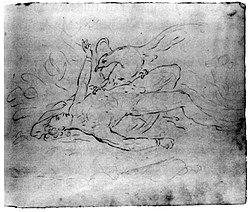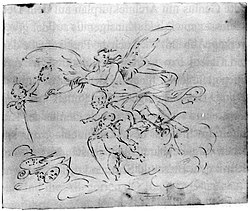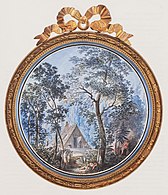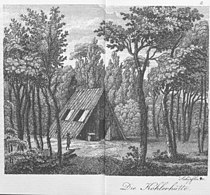Viktor Heideloff
Viktor Wilhelm Peter Heideloff (baptized June 29, 1757 in Stuttgart ; † May 11, 1817 in Stuttgart) was a German painter. Under the Württemberg Duke Karl Eugen , he mainly worked as a decorative painter for theaters and court festivals and as a painter of wall and ceiling paintings for the ducal palaces. He was also a professor of painting at the Hohen Karlsschule. Heideloff became known to posterity primarily through over 50 individual views of the former English village in Hohenheim in Stuttgart.
Life
Viktor Heideloff was baptized on June 29, 1757 in Stuttgart as one of eight children of the Württemberg court gilder Carl Heideloff and the dance master daughter Theresia Malterre. His grandfather was the sculptor Franz Joseph Ignatz Anton Heideloff.
Viktor Heideloff attended the Hohe Karlsschule in Stuttgart from 1771 to 1780 . His teachers included Nicolas Guibal , Adolf Friedrich Harper and the theater painter Giosuè Scotti. His classmates included Friedrich Schiller , the sculptor Johann Heinrich Dannecker , the officer Georg Friedrich Scharffenstein and the painters Philipp Friedrich von Hetsch , Philipp Jakob Scheffauer and Jakob Christian Schlotterbeck . In the years 1776 to 1780 Heideloff received a total of 5 competition prizes from the Karlsschule. After finishing school he was appointed court painter. At Heideloff's request, Duke Karl Eugen authorized him to study in Paris, Lyon, Marseille and Italy from the end of 1782 to 1785, with continued payment of his annual salary of 400 guilders.
From 1786 to 1793 Heideloff was a member of the residence building deputation. In 1788 he was employed as a theater painter with a salary of 600 florins. In 1789 he was appointed professor of painting and drawing at the Charles School, where he was employed with a salary of 800 guilders until it was closed in 1794. Heideloff was partially blind from 1804. He lost his pension and in the end had to live his life in poor conditions. Viktor Heideloff died on May 11, 1817 in Stuttgart at the age of almost 60.
plant
Viktor Heideloff's activity mainly extended to decorative paintings for the theater and court festivals as well as wall and ceiling paintings for Duke Karl Eugen's palaces. Heideloff became known to posterity primarily through more than 50 individual views of the English village and the drawing "Schiller reads five classmates from 'The Robbers'".
Views of the English village
The park on the site of what is now the Exotic Garden in Hohenheim, which with its 60 small architectures was intended to represent a rural colony in the middle of the ruins of a Roman city, was referred to as an English village. Between 1790 and 1797 Viktor Heideloff created individual views of the English village and occasionally other views of Hohenheim, for example of Hohenheim Castle. In 1790, while Duke Karl Eugen was still alive, he made 50 colored gouaches that were hung in one of the buildings in the English village, the “boudoir” and are now in the collection of the State Palaces and Gardens of Baden-Württemberg in Ludwigsburg Palace. After Karl Eugen's death, Heideloff published a scrapbook with 38 colored copperplate engravings in 1795 with the permission of his successor. In 1797 he delivered three booklets with two "interior views of the buildings and garden areas in Hohenheim" each. From 1795 to 1799 Gottlob Heinrich Rapp published a “Description of the garden in Hohenheim” with 45 black and white reproductions of engravings based on Heideloff's drawings in 5 installments in the “Pocket Calendar for Nature and Garden Friends”.
- 50 gouaches with views of the English village in Hohenheim, 1790, with gold frames, mostly round or oval.
- Viktor Heideloff: Views of the ducal-Württemberg country size Hohenheim / drawn from nature by V. Heideloff and explained with brief descriptions. Reproduction of the edition Nuremberg: Frauenholz, 1795, Stuttgart: Württembergische Landesbibliothek, 1986. - 38 colored copper engravings.
- Viktor Heideloff: Strangest internal views of the buildings and garden areas in Hohenheim, issue 1–3. Reproduction of the edition Nuremberg: Frauenholz, 1797, Stuttgart: Württembergische Landesbibliothek, 1986. - 6 colored aquatint leaves.
- Gottlob Heinrich Rapp : Description of the garden in Hohenheim. In: Pocket calendar for the year ... for nature and garden lovers. With images of Hohenheim and other coppers. Tübingen: Cotta, 1794–1798, reprint Stuttgart: Lithos-Verlag, 1992–1998. - With 45 copperplate engravings by various engravers after Heideloff's drawings.
"Views ..." ( #Heideloff 1795 ).
Other works
- 1778: Schiller reads to five classmates from “The Robbers”, drawing.
- 1780: “Le soir suspend tous les travaux”, round ceiling painting based on a design by Nicolas Guibal, Stuttgart, Neues Schloss.
- 1781: Stage curtain of the Komödienhaus in Ulm.
- 1782: Festival hunting at Bärensee on September 24, 1782.
- 1785: Duke Karl Eugen building Hohenheim Palace in 1785.
- 1790: “Apollo among the shepherds”, ceiling painting, Stuttgart, New Palace, 1790, destroyed in the Second World War.
- 1790: Four seasons, wall or ceiling painting, Stuttgart, New Palace.
- 1792: “St. Valentin blesses the children ”, oil painting, Rottweil, Heiligkreuzkirche, 2nd chapel on the north side.
- 1841: Watercolor painting by Joseph Neher with Heideloff's views of the English village on the walls of the playhouse in the Exotic Garden, restoration 1976.
family
The progenitor of the Heideloff family of artists was the sculptor Franz Joseph Ignatz Anton Heideloff (1676–1772). One of his sons was Viktor Heideloff's father, Carl Heideloff (1737–1803), the Stuttgart court golfer. His mother was Theresia Malterre (1731–1779), a daughter of Peter Heinrich Malterre (or Malter), who was employed as a dance master at the Karlsschule. Among the couple's 8 children were the sons Viktor Heideloff, the engraver Nikolaus Heideloff , the sculptor and painter Heinrich Heideloff, the painter Carl Heideloff (1770-1816) and the painter and gilder Jean Heideloff.
Viktor Heideloff married Maria Nanetta Keim (* 1766) from Ludwigsburg in 1788. She was the daughter of the master builder and theater machinist Johann Christian Keim (or Keym) and Maria Juliana Pellhammer from Regensburg. The marriage resulted in five children between 1789 and 1800, including the architect Carl Alexander Heideloff and the painter and engraver Manfred Heideloff (1793–1850).
literature
Life
- Viktor Heideloff . In: General Artist Lexicon . The visual artists of all times and peoples (AKL). Volume 71, de Gruyter, Berlin 2011, ISBN 978-3-11-023176-2 , p. 119.
- Johann Georg Meusel : Teutsches Künstlerlexikon or directory of German artists now living: together with a directory of libraries of interest, art, coin and natural history cabinets in Germany and Switzerland, volume 1. Lemgo: Meyer, 1808, pp. 372–373 ( [1 ] ).
- Georg Kaspar Nagler : New general artist lexicon or news of the life and works of painters, sculptors, builders, engravers, form cutters, lithographers, draftsmen, medalists, ivory workers, etc. Volume 6: Haspel – Keym. Fleischmann, Munich 1838, p. 53.
- Elisabeth Nau: Hohenheim: Castle and Gardens. With a contribution by Claudius Coulin. Sigmaringen: Thorbecke, 1978. - Numerous, mainly black and white illustrations of Heideloff's gouaches and views from #Heideloff 1795 .
- Viktor Wilhelm Peter Heideloff . In: Hans Vollmer (Hrsg.): General lexicon of fine artists from antiquity to the present . Founded by Ulrich Thieme and Felix Becker . tape 16 : Hansen – Heubach . EA Seemann, Leipzig 1923, p. 259-260 .
- Heideloff . In: Hans Vollmer (Hrsg.): General lexicon of fine artists from antiquity to the present . Founded by Ulrich Thieme and Felix Becker . tape 16 : Hansen – Heubach . EA Seemann, Leipzig 1923, p. 258-263 .
- Heinrich Wagner: History of the high Carls school. Volume 1: The Carls students according to archival sources. Etlinger, Würzburg 1856, pp. 462-463, 679-681.
plant
- Werner Gebhardt: The students of the Hohen Karlsschule: a biographical lexicon. Kohlhammer, Stuttgart 2014, p. 281.
- Viktor Heideloff; Klaus Herrmann (Ed.): Between Enlightenment and Romanticism: Hohenheim Castle. Without place, 1986. - 14 color images from #Heideloff 1795 .
- Patricia Peschel, Nadine Kröhn (editor): Evidence of a garden dream: the Hohenheim gouaches from the possession of Duke Carl Eugen von Württemberg. Regensburg: Schnell + Steiner, 2016. - With many color illustrations of the gouaches and the views from #Heideloff 1795 .
- Sabine Rathgeb: Studio & Vigilantia: the art academy at the Hohen Karlsschule in Stuttgart and its predecessor Académie des Arts. Hohenheim-Verlag, Stuttgart 2009, pp. 350, 353-354, 366, 372-373, 379-380, 512-514, 527, 550-551, 553.
- Max Schefold: Old Views from Württemberg. Volume 1: Illustrations. Kohlhammer, Stuttgart 1956. - See list of artists, p. 144.
- Max Schefold: Old Views from Württemberg. Volume 2: Catalog section. Kohlhammer, Stuttgart 1957. - Works in Hohenheim: Numbers 3176–3291, 3300–3339, other works: see list of artists, p. 888.
- Max Schefold: Old Views from Württemberg. Volume 3: Supplement to the catalog. Kohlhammer, Stuttgart 1974. - See list of artists, p. 415.
- H ans Schumann: Hohenheim: Pictures and Design. Ulmer, Stuttgart 1981. - With many color images from #Heideloff 1795 and #Heideloff 1797 .
Archives
- Stuttgart, archive of the University of Hohenheim, signature S3: Viktor Heideloff, views of Hohenheim / Englischer Garten, around 80 originals by Heideloff, 10 originals after Heideloff, around 150 repros.
Web links
Footnotes
- ↑ # Wagner 1856 , p. 462.
- ↑ #Wagner 1856 , p. 462, #Nagler 1838 .
- ↑ #Heideloff 1795 .
- ↑ #Heideloff 1795 .
- ↑ #Peschel 2016 , p. 111.
- ↑ #Rathgeb 2009 , pp. 353–354, Figure 19, 20.
- ↑ #Rathgeb 2009 , p. 366.
- ↑ #AKL .
- ↑ # Thieme-Becker, Viktor Heideloff .
- ^ Bernhard Carl Joseph von Neher the Younger (1806–1886), see German biography .
- ^ University of Hohenheim, historical circular route .
- ↑ #Gebhardt 2014 .
| personal data | |
|---|---|
| SURNAME | Heideloff, Viktor |
| ALTERNATIVE NAMES | Heideloff, Victor von; Heideloff, Viktor Wilhelm Peter |
| BRIEF DESCRIPTION | German painter |
| DATE OF BIRTH | baptized June 29, 1757 |
| PLACE OF BIRTH | Stuttgart |
| DATE OF DEATH | May 11, 1817 |
| Place of death | Stuttgart |














